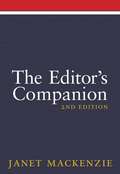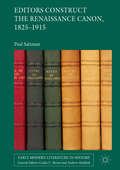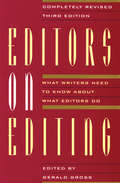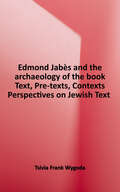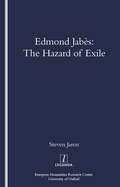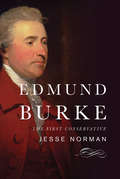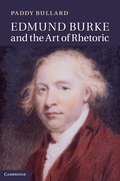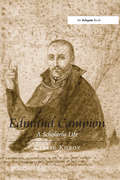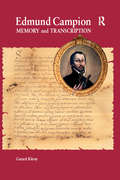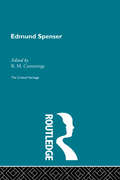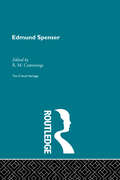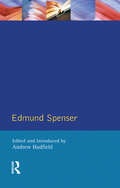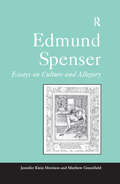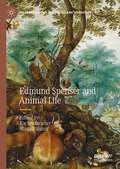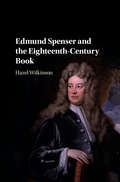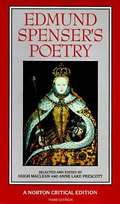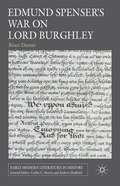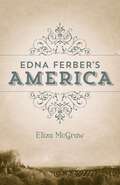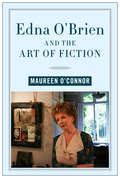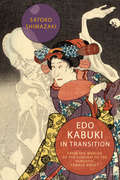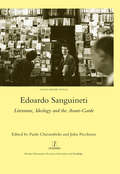- Table View
- List View
The Editor's Companion
by Janet MackenzieAs the knowledge economy takes shape, editors face many challenges. Technology is transforming publishing, text is losing out to graphics, and writing is distorted by cliché, hype and spin. More than ever, editors are needed to add value to information and to rescue readers from boredom and confusion. The Editor's Companion explains the traditional skills of editing for publication and how to adapt them for digital production. It describes the editorial tasks for print and screen publications, from fantasy novels and academic texts to web pages and government documents. It is an essential tool for professional editors, as well as media and publications officers, self-publishers and writers editing their own work. This revised edition features extended coverage of on-screen editing, single-source publishing and digital rights, a comprehensive glossary of editing terms and a companion website developed especially for students that includes editing exercises, expert 'tips' and essential weblinks.
Editors Construct the Renaissance Canon, 1825-1915 (Early Modern Literature in History)
by Paul SalzmanThis book argues that nineteenth-century editors created the modern idea of English Renaissance literature. The book analyses the theories and practices of editors who worked on Shakespeare, but also on complete editions of a remarkable range of early modern writers, from the early nineteenth century through to the early twentieth century. It reassesses the point at which purportedly more scientific theories of editing began the process of obscuring the work of these earlier editors. In recreating this largely ignored history, this book also addresses the current interest in the theory and practice of editing as it relates to new approaches to early modern writing, and to literary and book history, and the material conditions of the transmission of texts. Through a series of case studies, the book explores the way individual editors dealt with Renaissance literature and with changing ideas of how texts and their contexts might be represented.
Editors on Editing: What Writers Need to Know About What Editors Do (Books That Changed the World)
by Gerald GrossThe classic guide to the book publishing process, with essays by over three dozen professional editors: “Terrific.”—Judith Appelbaum, author of How to Get Happily PublishedFor decades, Editors on Editing has been indispensable for editors, aspiring editors, and especially writers who want to understand the publishing process, from how manuscripts are chosen for publication to what lunch with an agent is like. In this third revised edition of the book, thirty-eight essays are included to teach, inform, and inspire anyone interested in the world of editing. Covered are such topics as:the evolution of the American editorthe ethical and moral dimensions of editingwhat an editor looks for in a query letter, proposal, and manuscriptdevelopmental editing; line editing; copyediting; and freelance editingworking in different genres and markets, from science fiction to children’s books to Christian publishingthe question of political correctness in both nonfiction and fictionmaking the most of writers’ conferencesand many more
Editors, Scholars, and the Social Text
by Darcy CullenAn academic book is much more than paper and ink, pixels and electrons. A dynamic social network of authors, editors, typesetters, proofreaders, indexers, printers, and marketers must work together to turn a manuscript into a book.Editors, Scholars, and the Social Text explores the theories and practices of editing, the processes of production and reproduction, and the relationships between authors and texts, as well as manuscripts and books. By bringing together academic experts and experienced practitioners, including editorial specialists, scholarly publishing professionals, and designers, Editors, Scholars, and the Social Text offers indispensable insight into the past and future of academic communication.
Edmond Jabès And The Archaeology Of The Book: Text, Pre-texts, Contexts (Perspectives On Jewish Texts And Contexts Ser. #11)
by Tsivia Frank WygodaThis book offers a fresh reflection on The Book of Questions by the French-Egyptian Jewish writer Edmond Jabès and its readings and proposes to re-contextualize Jabès' enigmatic prose through the lens of the author’s manuscripts. Addressed are the main prisms through which Jabès’ oeuvre has been read since its publication in 1963: Jewishness, the Shoah, intertextuality with Midrash and Kabbalah, hermeticism and interpretation. It analyzes their shapes and their becoming in the work-in-progress, reveals the dynamics and the contexts of their evolution from the pre-texts to the text and beyond, and reflects on the relationship between creation, interpretation, and writing as a process. It seeks to rethink our reading of The Book of Questions and the poetics and hermeneutics of enigmatic writing.
Edmond Jabes and the Hazard of Exile: The Hazard of Exile
by Steven Jaron"For a man who no longer has a homeland, writing becomes a place to live (Theodor Adorno). The Jewish writer Edmond Jabes, born in Cairo in 1912, wrote explicitly from the perspective of exile once he arrived in France after the Suez crisis. However, Jaron argues, exile was a predominant theme even before Jabes left Egypt. He brings to light the author's associations with other francophone writers in Egypt, especially those affiliated with the Surrealists, but shows that metropolitan France exerted a greater pull. Drawing on unpublished archival and rare printed sources, Jaron examines how Jabes opposed anti-Semitism during the 1930s, and later placed the Shoah at the heart of his acclaimed ""Livres des Questions"" (1963-73)."
Edmund Burke: The First Conservative
by Jesse NormanEdmund Burke is both the greatest and the most underrated political thinker of the past three hundred years. A brilliant 18th-century Irish philosopher and statesman, Burke was a fierce champion of human rights and the Anglo-American constitutional tradition, and a lifelong campaigner against arbitrary power. Once revered by an array of great Americans including Presidents Theodore Roosevelt and Woodrow Wilson, Burke has been almost forgotten in recent years. But as politician and political philosopher Jesse Norman argues in this penetrating biography, we cannot understand modern politics without him. As Norman reveals, Burke was often ahead of his time, anticipating the abolition of slavery and arguing for free markets, equality for Catholics in Ireland, responsible government in India, and more. He was not always popular in his own lifetime, but his ideas about power, community, and civic virtue have endured long past his death. Indeed, Burke engaged with many of the same issues politicians face today, including the rise of ideological extremism, the loss of social cohesion, the dangers of the corporate state, and the effects of revolution on societies. He offers us now a compelling critique of liberal individualism, and a vision of society based not on a self-interested agreement among individuals, but rather on an enduring covenant between generations. Burke won admirers in the American colonies for recognizing their fierce spirit of liberty and for speaking out against British oppression, but his greatest triumph was seeing through the utopian aura of the French Revolution. In repudiating that revolution, Burke laid the basis for much of the robust conservative ideology that remains with us to this day: one that is adaptable and forward-thinking, but also mindful of the debt we owe to past generations and our duty to preserve and uphold the institutions we have inherited. He is the first conservative. A rich, accessible, and provocative biography, Edmund Burke describes Burke’s life and achievements alongside his momentous legacy, showing how Burke’s analytical mind and deep capacity for empathy made him such a vital thinker#151;both for his own age, and for ours.
Edmund Burke and the Art of Rhetoric
by Paddy BullardEdmund Burke ranks among the most accomplished orators ever to debate in the British Parliament. But often his eloquence has been seen to compromise his achievements as a political thinker. In the first full-length account of Burke's rhetoric, Bullard argues that Burke's ideas about civil society, and particularly about the process of political deliberation, are, for better or worse, shaped by the expressiveness of his language. Above all, Burke's eloquence is designed to express ethos or character. This rhetorical imperative is itself informed by Burke's argument that the competency of every political system can be judged by the ethical knowledge that the governors have of both the people that they govern and of themselves. Bullard finds the intellectual roots of Burke's 'rhetoric of character' in early modern moral and aesthetic philosophy, and traces its development through Burke's parliamentary career to its culmination in his masterpiece, Reflections on the Revolution in France.
Edmund Campion: A Scholarly Life
by Gerard KilroyEdmund Campion: A Scholarly Life is the response, at long last, to Evelyn Waugh’s call, in 1935, for a ’scholarly biography’ to replace Richard Simpson's Edmund Campion (1867). Whereas early accounts of his life focused on the execution of the Jesuit priest, this new biography presents a more balanced assessment, placing equal weight on Campion’s London upbringing among printers and preachers, and on his growing stature as an orator in an Oxford riven with religious divisions. Ireland, chosen by Campion as a haven from religious conflict, is shown, paradoxically, to have determined his life and his death. Gerard Kilroy here draws on newly discovered manuscript sources to reveal Campion as a charismatic and affectionate scholar who was finding fulfilment as priest and teacher in Prague when he was summoned to lead the first Jesuit mission to England. The book argues that the delays in his long journey suggest reluctant acceptance, even before he was told that Dr Nicholas Sander had brought ’holy war’ to Ireland, so that Campion landed in an England that was preparing for papal invasion. The book offers fresh insights into the dramatic search for Campion, the populist nature of the disputations in the Tower, and the legal issues raised by his torture. It was the monarchical republic itself that, in pursuit of the Anjou marriage, made him the beloved ’champion’ of the English Catholic community. Edmund Campion: A Scholarly Life presents the most detailed and comprehensive picture to date of an historical figure whose loyalty and courage, in the trial and on the scaffold, swiftly became legendary across Europe.
Edmund Campion: Memory and Transcription
by Gerard KilroyThe death of Edmund Campion in 1581 marked a disjunction between the world of printed untruth and private, handwritten, truth in early modern England. Gerard Kilroy traces the circulation of manuscripts connected with Campion to reveal a fascinating network that not only stretched from the Court to Warwickshire and East Anglia but also crossed the confessional boundaries. Kilroy shows that in this intricate web Sir John Harington was a key figure, using his disguise as a wit to conceal a lifelong dedication to Campion's memory. Sir Thomas Tresham is shown as expressing his devotion to Campion both in his coded buildings and in a previously unpublished manuscript, Bodleian MS Eng. th. b. 1-2, whose theological and cultural riches are here fully explored. This book provides startling new views about Campion's literary, historical and cultural impact in early modern England. The great strength of this study is its exploitation of archival manuscript sources, offering the first printed text and translation of Campion's Virgilian epic, a fully collated text of 'Why doe I use my paper, ynke and pen', and Harington's four decades of theological epigrams, printed for the first time in the order he so carefully designed. Edmund Campion: Memory and Transcription lays the foundations of the first full literary assessment of Campion the scholar, the impact he had on the literature of early modern England, and the long legacy in manuscript writing.
Edmund Spencer: The Critical Heritage
by R. M. CummingsThis book examines Edmund Spenser's essays. It presents the criticisms of John Dryden, which are determined by his own preoccupations than by his reading of other critics, and contains three larger sections (covering the periods 1579-1600, 1600-1660, 1660-1715) into which all this material falls.
Edmund Spencer: The Critical Heritage
by R. M. CummingsFirst published in 2003. Routledge is an imprint of Taylor & Francis, an informa company.
Edmund Spenser (Longman Critical Readers)
by Andrew HadfieldThis collection represents some of the best recent critical writing on Edmund Spenser, a major Renaissance English poet. The essays cover the whole of Spensers work, from early literary experiments such as The Shepeardes Calendar, to his unfinished crowning work,The Fairie Queene. The introduction provides an overview of critical responses to Spenser, setting his work and the debates which it has generated in their perspective contexts: new historicist, post-structural, psychoanalytic and feminist. His study also covers the critical responses of leading British, Irish and American scholars.
Edmund Spenser: Essays on Culture and Allegory
by Jennifer Klein Morrison Matthew GreenfieldThough his writings have long been integral to the canon of early modern English literature, it is only in very recent scholarship that Edmund Spenser has been understood as a preeminent anthropologist whose work develops a complex theory of cultural change. The contributors to this volume approach Spenser’s work from that new perspective, rethinking his contribution as a theorist of culture in light of his poetics. The essays in the collection begin with close readings of Spenser’s writings and end by challenging the ethnographic allegories that shape our knowledge of early modern England. In this book Spenser is proven to be not only a powerful theorist of allegory and poetics but also a profound and subtle ethnographer of England and Ireland. This is an interdisciplinary volume, incorporating studies on history and art history as well as literary criticism. The essays are based on papers presented at The Faerie Queen in the World, 1596-1996: Edmund Spenser among the Disciplines , a conference which took place at the Yale Center for British Art in September 1996.
Edmund Spenser and Animal Life (Palgrave Studies in Animals and Literature)
by Rachel Stenner Abigail ShinnThis book is the first extended critical study of the early modern poet Edmund Spenser from the perspective of animal studies. With an introduction situating Spenser in current discussions of animal life and literary form, and early modern animal studies, the book proceeds in four sections: “Animals and Cultural Practices”; “Animals, Slavery, and Race”; “Animals in Complaints”; “Readers and Poetics in The Faerie Queene”. Contributors discuss a broad range of Spenser’s work, putting it into dialogue with a number of early modern discourses, including politics, poetics, and natural history.
Edmund Spenser and the Eighteenth-Century Book
by Hazel WilkinsonEdmund Spenser's epic poem The Faerie Queene (1590-96) occupied an important place in eighteenth-century culture. Spenser influenced almost every major writer of the century, from Alexander Pope to William Wordsworth. What was it like to read Spenser in the eighteenth century? Who made Spenserian books, and how did their owners use and interpret them? The first comprehensive study of all of the eighteenth-century editions of Edmund Spenser addresses these questions through bibliographical analysis, and through examination of the history of the book and of eighteenth-century literature and culture. Within these contexts, Hazel Wilkinson provides new information about the production, contents, texts, and reception of the eighteenth-century editions of Spenser, to illuminate how his cultural presence became so far-reaching. With each chapter structured around a major edition of Spenser's work, this volume provides a timely addition to arguments about the nature of literary history and the growing cult of great writers of the past.
Edmund Spenser in Context
by Andrew EscobedoEdmund Spenser's poetry remains an indispensable touchstone of English literary history. Yet for modern readers his deliberate use of archaic language and his allegorical mode of writing can become barriers to understanding his poetry. This volume of thirty-seven essays, written by distinguished scholars, offers a rich introduction to the literary, political and religious contexts that shaped Spenser's poetry, including the environment in which he lived, the genres he drew upon, and the influences that helped to fashion his art. The collection reveals the multiple personae that Spenser constructs within his work: to read Spenser is to read a rich archive of literary forms, and this volume provides the contexts in which to do so. A further reading list at the end of the volume will prove invaluable to further study.
Edmund Spenser's Poetry (A Norton Critical Edition, 3rd edition)
by Edmund Spenser Hugh D. Maclean Anne L. PrescottBuilding on the strengths of two previous editions, this revised and enlarged Third Edition continues to offer more of Spenser's poetry than any other comparable volume.
Edmund Spenser�s War on Lord Burghley
by Bruce DannerEdmund Spenser's censored attacks on Lord Burghley (Elizabeth I's powerful first minister) serve as the basis for a reassessment of the poet's mid-career, challenging the dates of canonical texts, the social and personal contexts for scandalous topical allegories, and the new historicist portrait of Spenser's 'worship' of power and state ideology.
Edna Ferber's America: The Free North and Southern Domination, 1780--1860
by Eliza McGrawFrom the 1910s to the 1950s, Edna Ferber (1885--1968) published a series of bestselling novels that made her one of Doubleday's highest-paid authors, earned her a Pulitzer Prize for Fiction in 1925, and transformed her into a literary celebrity. She hosted dinner parties covered by the New York Times, lunched at the Algonquin Round Table with Dorothy Parker and Alexander Woollcott, and collaborated with George S. Kaufman on hit plays such as Dinner at Eight and Stage Door. In Edna Ferber's America, Eliza McGraw provides the first in-depth critical study of the author's novels, exploring their innovative portrayals of characters from a diverse range of ethnicities and social classes.Best remembered today for the movies and musicals adapted from her works -- including classics like Giant and Show Boat -- Ferber attracted a devoted readership during her lifetime with engaging storylines focused on strong-willed individuals reshaping their lives, set amid a panorama of regional landscapes. McGraw reveals that Ferber's novels convey a broad, nuanced vision of the United States as a multiethnic country.Framing her study with the theme of ethnic unease and insecurity, McGraw performs close readings of twelve Ferber novels: Dawn O'Hara (1911), Fanny Herself (1917), The Girls (1921), So Big (1924), Show Boat (1926), Cimarron (1929), American Beauty (1931), Come and Get It (1935), Saratoga Trunk (1941), Great Son (1945), Giant (1952), and Ice Palace (1958). McGraw explores the entwined topics of racial mixing and class as she argues that in Ferber's America, ethnic and social mobility challenge the reigning order, creating places that foster vitality and promise hope for the future.
Edna O'Brien and the Art of Fiction (Contemporary Irish Writers)
by Maureen O'ConnorSince the appearance of her first novel, The Country Girls, in 1960—a book that undermined the nation’s ideal of innocent and pious Irish girlhood—Edna O’Brien has provoked controversy in her native Ireland and abroad. Indeed, several of her early novels were condemned by church authorities and banned by the Irish government for their frank portrayals of sexual matters and the inner lives of women. Now an internationally acclaimed writer, O’Brien must be critically reassessed for a twenty-first century audience. Edna O’Brien and the Art of Fiction provides an urgent retrospective consideration of one of the English-speaking world’s best-selling and most prolific contemporary authors. Drawing on O’Brien’s fiction as well as archival material, and applying new theoretical approaches—including ecocritical and feminist new materialist readings—this study considers the pioneering and enduring ways O’Brien represents women’s experience, family relationships, the natural world, sex, creativity, and death, and her work’s long anticipation of contemporary movements such as #metoo.
Edo Kabuki in Transition: From the Worlds of the Samurai to the Vengeful Female Ghost
by Satoko ShimazakiSatoko Shimazaki revisits three centuries of kabuki theater and its dynamic representations of medieval Japanese tales and tradition, boldly reframing Edo kabuki as a key player in the formation of an early modern urban identity. Challenging the common understanding of kabuki as a subversive entertainment and a threat to shogunal authority, Shimazaki argues that kabuki actually instilled a sense of shared history in Edo's inhabitants, regardless of their class. It did this, she shows, by constantly invoking "worlds," or sekai, largely derived from medieval military chronicles, and overlaying them onto the present. Shimazaki explores the process by which, as the early modern period drew to a close, nineteenth-century playwrights began dismantling the Edo tradition of "presenting the past" by abandoning their long-standing reliance on the sekai. She then reveals how, in the 1920s, a new generation of kabuki playwrights, critics, and scholars reinvented the form yet again, "textualizing" kabuki so that it could be pressed into service as a guarantor of national identity, in keeping with the role that the West assigned to theater. Shimazaki's vivid and engaging reinterpretation of kabuki history centers on the popular and widely celebrated ghost play Tokaido Yotsuya kaidan (Ghost Stories at Yotsuya, 1825) by Tsuruya Nanboku. Along the way, she sheds fresh light on the emergence and development of the ubiquitous trope of the vengeful female ghost, linking it to the need to explore new themes at a time when the old samurai worlds were rapidly losing their relevance.
Edo Kabuki in Transition: From the Worlds of the Samurai to the Vengeful Female Ghost
by Satoko ShimazakiSatoko Shimazaki revisits three centuries of kabuki theater, reframing it as a key player in the formation of an early modern urban identity in Edo Japan and exploring the process that resulted in its re-creation in Tokyo as a national theatrical tradition. Challenging the prevailing understanding of early modern kabuki as a subversive entertainment and a threat to shogunal authority, Shimazaki argues that kabuki instilled a sense of shared history in the inhabitants of Edo (present-day Tokyo) by invoking "worlds," or sekai, derived from earlier military tales, and overlaying them onto the present. She then analyzes the profound changes that took place in Edo kabuki toward the end of the early modern period, which witnessed the rise of a new type of character: the vengeful female ghost.Shimazaki's bold reinterpretation of the history of kabuki centers on the popular ghost play Tokaido Yotsuya kaidan (The Eastern Seaboard Highway Ghost Stories at Yotsuya, 1825) by Tsuruya Nanboku IV. Drawing not only on kabuki scripts but also on a wide range of other sources, from theatrical ephemera and popular fiction to medical and religious texts, she sheds light on the development of the ubiquitous trope of the vengeful female ghost and its illumination of new themes at a time when the samurai world was losing its relevance. She explores in detail the process by which nineteenth-century playwrights began dismantling the Edo tradition of "presenting the past" by abandoning their long-standing reliance on the sekai. She then reveals how, in the 1920s, a new generation of kabuki playwrights, critics, and scholars reinvented the form again, "textualizing" kabuki so that it could be pressed into service as a guarantor of national identity.
Edoardo Sanguineti: Literature, Ideology and the Avant-garde
by John Picchione"Poet, novelist, theorist, playwright, translator, politician, and teacher, Edoardo Sanguineti (1930-2010) is one of the most original and influential Italian intellectuals of the second post-war period. An ardent and unremitting historical materialist, he investigated the links between language and ideology, literature and the other arts, together with their functions within the logic of late capitalism. The extraordinary range of his creative work persistently defies conventional aesthetic notions. With their variety of topics and critical perspectives, the essays assembled in this volume explore both the relevance of his theoretical postures and the ideological and formal fabric of his literary production. They highlight his subversive objectives, the complexity of the language, the astonishing linguistic ingenuity, metaliterary significance, whimsical disposition, and provocative social critique. Testimonials by Sanguineti's colleagues and students, presented here in English translation, offer a portrait of the man, his temperament and his distinctiveness, and provide a personal view of the life and work of a brilliant intellectual."
Eduard Mörike: The Man and the Poet
by Margaret MareOriginally published in 1957, this was the first biography and full account of Eduard Mörike’s works to appear in English. One of the greatest German lyric poets, Mörike is, according to some critics equal to Goethe as a lyricist. This book was the first attempt to analyse Mörike’s highly suggestive drawings, some of which are reproduced in the book. The contents of poems are summarized, so no prior knowledge of German is assumed, and a large number of poems are quoted in full.
